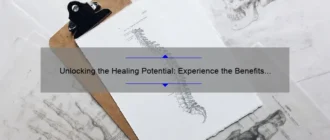Chiropractic subluxation refers to a theoretical condition wherein there is an abnormal alignment or movement of spinal vertebrae. Some chiropractors believe that subluxations can cause various health problems. However, this concept is not supported by scientific evidence and is considered pseudoscience by mainstream medicine.
What is a chiropractic subluxation?
A chiropractic subluxation refers to a condition where there is a misalignment or partial dislocation of one or more vertebrae in the spine. This misalignment can interfere with the proper functioning of the nervous system, resulting in various health issues. Chiropractors believe that correcting these subluxations through manual adjustments can restore proper alignment and promote overall well-being.
How can chiropractic subluxations affect my health?
Chiropractic subluxations, which refer to misalignments of the spine, can potentially affect your health in several ways. Firstly, these subluxations can disrupt the communication between your brain and the rest of your body, hindering the optimal function of the nervous system. Since the nervous system controls and coordinates all bodily functions, including organ function, muscle control, and immune responses, any disruptions can lead to various health issues.
Chiropractic subluxations may result in pain and discomfort, as well as restricted mobility. These misalignments can put pressure on nerves and cause inflammation, leading to pain in the affected area and potential referred pain in other parts of the body.
Moreover, subluxations can also contribute to postural problems, muscle imbalances, and joint dysfunctions. These issues can result in diminished range of motion, increased muscle tension, and an increased likelihood of injuries.
By addressing these subluxations through chiropractic adjustments, chiropractors aim to restore proper alignment and function to the spine. This can help alleviate pain and discomfort, improve mobility, and enhance the overall function of the nervous system, positively impacting your health and well-being.
Can chiropractic adjustments help treat subluxations?
Yes, chiropractic adjustments can help treat subluxations. Chiropractors are trained to identify and correct subluxations, which occur when there is a partial displacement or misalignment of the joints or vertebrae in the spine. By applying controlled force or pressure to specific areas of the spine, chiropractic adjustments aim to restore proper alignment and function, thereby alleviating pain, improving mobility, and promoting overall health and well-being.
Are chiropractic subluxations the same as spinal misalignments?
No, chiropractic subluxations and spinal misalignments are not the same. Chiropractic subluxations refer to a slight misalignment or displacement of the vertebrae that can affect the nervous system’s function. On the other hand, spinal misalignments generally refer to any deviation from the normal alignment of the spinal bones, which can have various causes, including trauma, poor posture, or degenerative conditions. While they can overlap in some cases, they are not synonymous.
Are there any symptoms or signs of chiropractic subluxations?
Chiropractic subluxations are a controversial concept within the chiropractic profession. Some chiropractors believe that subluxations, which they define as misalignments of the vertebrae, can cause various health problems and produce symptoms. However, there is limited scientific evidence to support the existence of subluxations or their association with specific symptoms. Many mainstream medical professionals and scientific organizations do not recognize subluxations as a legitimate medical condition. Nonetheless, some individuals who receive chiropractic care may report experiencing relief from certain symptoms following chiropractic adjustments. It is essential to consult with a healthcare professional to determine the most appropriate treatment for specific health concerns.
How do chiropractors diagnose and treat subluxations?
Chiropractors diagnose subluxations through a combination of physical exams, patient history, and potentially diagnostic imaging tests. The physical exam may include assessing spinal motion, muscle tone, and other bodily functions. Patient history helps provide insights into the root cause of the subluxation. Diagnostic imaging tests like X-rays or MRI scans may be used to further evaluate the condition.
Regarding treatment, chiropractors typically use spinal adjustments or manipulations to correct subluxations. This involves applying controlled force to the affected joint in order to restore its proper alignment and function. Chiropractors may also recommend other complementary therapies like stretching, exercises, heat/cold therapy, or lifestyle modifications to support the healing process and prevent future subluxations. It is important to note that chiropractic treatment plans may vary based on the individual and the severity of the subluxation.
Is it possible to prevent or reduce the occurrence of subluxations?
Yes, it is possible to prevent or reduce the occurrence of subluxations. Regular chiropractic care and spinal adjustments can help maintain proper alignment and minimize the chances of subluxations. Additionally, practicing good posture, engaging in regular exercise, maintaining a healthy weight, and avoiding activities that strain the spine can also help prevent subluxations.
Are subluxations only limited to the spine or can they occur in other joints as well?
Subluxations can occur in other joints as well, not just limited to the spine. Any joint in the body has the potential to experience a subluxation, which is a partial or incomplete dislocation where the joint surfaces are partially displaced from their normal position.
What are the potential benefits of chiropractic care for subluxations?
Chiropractic care for subluxations has several potential benefits. Firstly, it can help relieve pain and discomfort caused by subluxations, which are misalignments of the vertebrae. Chiropractic adjustments can help realign the spine, reducing pressure on nerves and promoting proper functioning of the musculoskeletal system.
Additionally, chiropractic care can improve joint mobility and flexibility. Subluxations can restrict movement and lead to stiffness, but regular chiropractic adjustments can restore proper joint function, enhancing range of motion and overall mobility.
Furthermore, chiropractic care focuses on holistic health and wellness. A chiropractor may provide advice on lifestyle modifications, exercises, and stretches that can complement the adjustments and promote overall health. By addressing subluxations, chiropractic care can support the body’s natural healing processes, improve posture, enhance immune function, and promote better sleep.
Overall, the potential benefits of chiropractic care for subluxations include pain relief, improved joint mobility, enhanced overall health, and the promotion of the body’s self-healing abilities.
How long does it take to resolve a chiropractic subluxation?
The length of time it takes to resolve a chiropractic subluxation can vary depending on various factors such as the severity of the subluxation, individual response to treatment, and consistency of chiropractic care. In some cases, people may experience relief after just a few sessions, while others may require ongoing treatment over the span of several weeks or months. Ultimately, the duration of resolution can only be determined on a case-by-case basis.
| Term | Definition |
|---|---|
| Chiropractic | A healthcare profession that focuses on the diagnosis and treatment of musculoskeletal disorders, primarily through manual adjustments and manipulations of the spine. |
| Subluxation | A condition in which the alignment, movement, or function of a joint is impaired, causing dysfunction and potential symptoms or health issues. |
| Chiropractic Subluxation | A term used in chiropractic medicine to describe a specific type of subluxation that affects the spine and its surrounding structures, potentially leading to pain, reduced mobility, and other related symptoms. |






